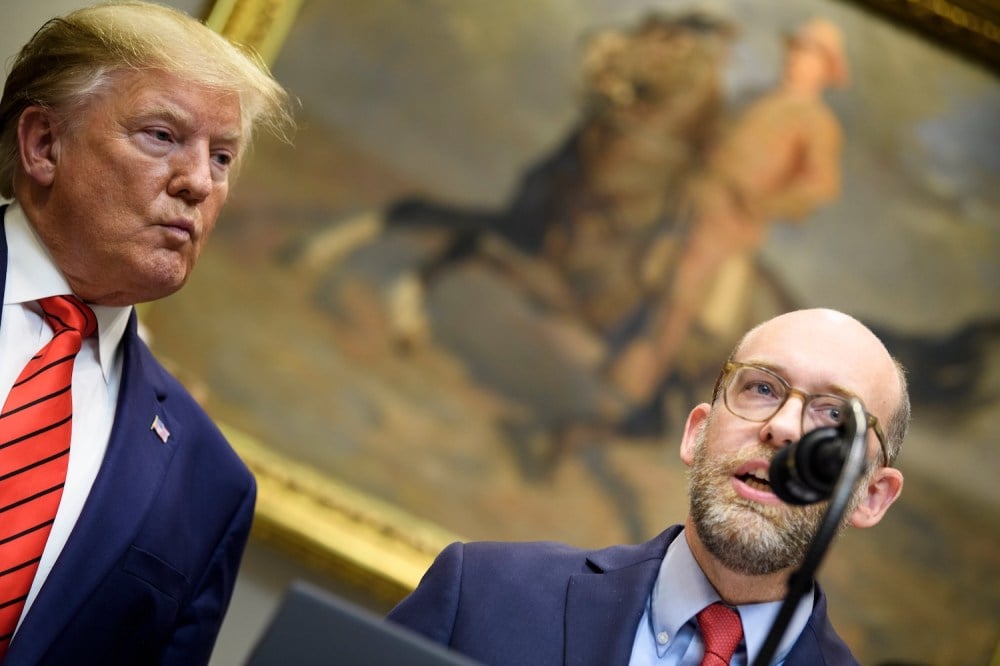Copyright Foreign Policy

Russell Vought is one of the most powerful people in Washington. The director of the Office of Management and Budget (OMB), also a leading architect of Project 2025, is running roughshod over federal workers, federal spending, and federal regulations. Quietly, methodically, and brutally, Vought is manifesting the mission that Steve Bannon called for years ago: destruction of the administrative state. In contrast to Tesla titan Elon Musk, who acted as a wrecking ball when he served as the head of the Department of Government Efficiency, Vought is much more deliberate in the way that he uses existing government processes to his advantage. He has been exploiting ambiguities, vulnerabilities, and loopholes in federal processes and administrative rules to tear down the government that President Donald Trump heads. VoughtBBs power did not come out of nowhere. In an insightful profile for The New Yorker, Andy Kroll explained that Vought is powerful simply by the fact he controls the OMB: “What it lacks in cachet, however, it makes up for in the vast influence it wields across the government.” But how did this “little known” office become such a political behemoth? What made this agency filled with number-crunchers such an awesome force? The story of the contemporary OMB goes back to the 1980s when Ronald Reagan was president. Reagan revived President Richard Nixon’s effort to deploy presidential power as a conservative weapon to be wielded against liberalism. By the time he left office in 1989, Reagan left behind a formidable federal agency that, in Vought’s hands, has become an existential threat to the collective legacy of Franklin Roosevelt, Lyndon Johnson, Barack Obama, and, most recently, Joe Biden. Modern presidential budgeting began with the Budget and Accounting Act of 1921. The legislation, which created the Bureau of the Budget (BOB), was passed as part of the progressive-era project at the turn of the 20th century aimed at modernizing government, strengthening efficiency, and expanding the role of nonpartisan expertise in Washington. Through the legislation, presidential administrations started to propose a unified executive budget to send to Congress each year—rather than relying on the existing decentralized process whereby each agency requested funds from Congress or through the Treasury Department, which then presented the multiple plans on Capitol Hill. The first director of the BOB, Charles Dawes, quickly burnished the reputation of the bureau and built up a respectable staff that allowed it to design and draft a budget. As the size of the federal government increased during the Great Depression in the 1930s and World War II in the early 1940s, the role of the BOB expanded as well. In 1939, Roosevelt shifted the bureau from sitting under the auspices of the Department of the Treasury into the Executive Office of the President, where the director could be closer to the president. By the end of the decade the professional staff had grown to about 600 from 40. During World War II, BOB Director Harold Smith asserted his agency in administrative decisions connected to the wartime mobilization. Smith insisted that obliged each agency to communicate through his office before reaching out to Congress with requests. The Division of Statistical Standards, a unit bolstered under Smith, provided greater quantitative analysis as Smith made these interventions. The BOB also took on more direct roles in budgetary planning and evaluation. One member of Congress told Time that “We grant the powers and Harold Smith writes the laws.” During the next burst of liberal governance, the BOB kept growing. President Lyndon Johnson required agencies to adopt the Planning-Programming-Budgeting System, which helped the BOB in its decisions and to evaluate what different components of the executive branch wanted to do. Previously used at the Defense Department, the managerial system pushed every federal agency to better align budget priorities for each agency with planning, programming, and budgeting. Nixon undertook reforms in 1970, including his rebranding the bureau as the Office of Management and Budget. Nixon charged the OMB with overseeing the policies that each agency was undertaking and continually evaluating the quality of their managerial staff. “I’m for more management of the bureaucracy, not less,” noted Nixon aide John Ehrlichman. Under Directors George Shultz and Caspar Weinberger, Nixon’s OMB moved to the front lines of the president’s drive to reduce government spending. The multidecade expansion of executive budgetary power came to a temporary halt when Congress attempted to reassert its control over the executive branch in the aftermath of the Watergate scandal. The Congressional Budget and Impoundment Control Act of 1974 counteracted the steady growth of presidential power that had taken place over five decades. The legislation created the House and Senate budget committees to coordinate tax and spending decisions, the budget reconciliation process that centralized decision-making and prohibited the filibuster, and the Congressional Budget Office to provide expertise matching the OMB. It also imposed limits on the president’s ability to impound funds. Then came Reagan. The president reasserted presidential power with the OMB standing at the forefront of his fight to reclaim power and tame the federal government. Like Nixon, Reagan believed that executive power was essential to overcoming the Democratic House, entrenched liberal interest groups, and a sizable federal bureaucracy that he believed had little interest in change. The OMB, Reagan realized, was a perfect tool to achieve his goals. To restore the dominance of the OMB, Reagan appointed a hard-charging David Stockman to be director. The former Michigan congressman became the point person in pushing the president’s supply-side economic agenda: cutting government spending and lowering taxes for wealthier Americans and corporations. From the moment he was appointed, Stockman “began cranking up the budget-cutting machinery on a frantic schedule.” Stockman applied immense pressure on legislators as well as cabinet officials. He was relentless in pursuit of the historic Economic Recovery Tax Act of 1981 that Reagan signed into law in August, which lowered the top rate from 70 percent to 50 percent. Even some free-market conservatives in the administration were taken aback by Stockman’s power grab. “What kind of bureaucracy are you building up over at OMB?” asked Transportation Secretary Drew Lewis after frequent clashes with him. Stockman was caught up in a media storm after William Greider published an article, “The Education of David Stockman,” in the Atlantic, where he quoted the budget director as admitting the flimsy math on which they had based their assurances that tax cuts would not result in ballooning deficits. He admitted he never had much faith in the administration’s economic theories. “We didn’t think it all the way through,” Stockman had admitted to Greider. “We didn’t add up all the numbers.” Under Stockman and his successors in the 1980s, the OMB exercised a much stronger hand in drafting legislation, issuing public statements, and conducting outreach to Congress. One of the main advantages that Reagan saw in the agency was that much of its business took place behind closed doors. “The Reagan administration found the OMB especially useful,” wrote the historian Samuel Hays in Beauty, Health, and Permanence, “as an agency where decision making was not subject to the scrutiny of the public, Congress, or the courts. It was able to avoid the open administrative procedures that the courts had fashioned over the years … it constituted one of the most significant elements of the Reagan antienvironmental revolution.” But Stockman had less of a long-lasting impact than the structural changes undertaken between 1981 and 1989. Through Reagan’s Executive Order 12291, the OMB was granted vast oversight over new federal regulations. Agencies were required to submit proposed new major rules (defined as having an impact of $100 million or more) so that the OMB could subject them to an economic cost-benefit analysis. The Office of Information and Regulatory Affairs, created by the Paperwork Reduction Act under President Jimmy Carter in 1980, was charged under Reagan with approving or disapproving the forms and recordkeeping rules that executive and independent agencies released. If the OMB approved of a proposal, then it could be entered into the Federal Register for public scrutiny. Thereafter, the agency would have to provide yet another impact statement to OMB for analysis that the agencies had to follow. With Reagan in the White House, the OMB became the “toughest kid on the block,” according to one top official, James C. Miller. The OMB used the new rules to knock down numerous workplace and environmental regulations. Congress passed the Gramm-Rudman-Hollings Balanced Budget Act in 1985, which enacted a sequestration process that required automatic spending cuts if Congress did not fulfill its annual deficit targets. If the OMB determined that the targets were not being met, the office could then issue the sequestration order, working with the head of the Congressional Budget Office, to make its recommendations to the comptroller general. When the Supreme Court ruled in 1986 that the comptroller general could not oversee the spending cuts, the authority of the OMB in the sequestration process expanded. The OMB continued to gain strength in the coming decades under Republican and Democratic presidents. No longer leading a small government office that primarily spent its time assisting the president to craft his budget, the director of the OMB had become a dominant force in his own right who commanded immense budgetary, administrative, and regulatory power. By the time Trump started his second term, it made sense that he would put one of the most important figures in his orbit atop that office. Through the OMB, Vought had the best opportunity to turn Project 2025 from an oversized manual into the governing policies of the land. Vought has not disappointed. While there is a long time to go in Trump’s second term, he has established himself as one of the most influential and feared budgetary directors since the BOB was created in 1921. Like so much of Trump 2.0, his tenure underscores the need for long-term structural reform once his administration ends, if not sooner. While there are many elements of the current presidency that many critics believe to be illegal or, at a minimum, clear violations of executive authority, much of how the president and his team assert their power involves working through the system rather than around it. They deploy pre-existing executive authority in new ways, push the boundaries of how far the authority can reach, and then exploit ambiguities in rules and laws to accomplish what other administrations either refused to or never imagined possible. Until stronger restraints are imposed on executive authority, such as the power of the OMB, there will always be the possibility that future presidents, long after Trump is gone, will replicate his record and possibly go even further in using one strong arm of government to gut the rest.



